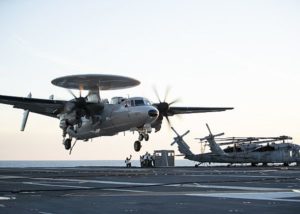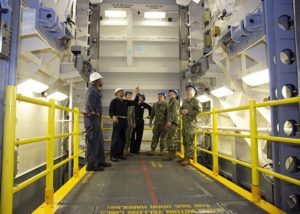The USS Gerald R. Ford (CVN-78) aircraft carrier started Aircraft Compatibility Testing (ACT) last week while Navy officials noted this will be one of 11 underway times during the Post Delivery Test and Trial (PDT&T) period.
The Ford left its Norfolk, Va., homeport on Jan. 16 to start the ACT and the first aircraft, an E-2D Advanced Hawkeye, landed on the deck that day.

ACT will continue additional at-sea testing of the new Electromagnetic Aircraft Launch System (EMALS) and Advanced Arresting Gear (AAG) systems. Ford last tested the launch and recovery systems in 2018 with the F/A-18 E/F Super Hornet.
This ACT phase will cover compatibility testing with the T-45 Goshawk trainers, Super Hornets, and E/A-18G Growlers from Air Test and Evaluation Squadron 23 as well as E-2D Advanced Hawkeyes and C-2A Greyhounds from Air Test and Evaluation Squadron 20.
The Navy said this will be the first time the T-45, E-2D, C-2A and E/A-18G will launch and recover from the Ford.
The carrier has had 747 launches and arrestements each so far, while the service said this next round will help the crew further test improvements made during the post-shakedown availability at shipbuilder Huntington Ingalls Industries’ [HII] Newport News Shipbuilding shipyard.
The Ford last flew aircraft in January 2018.
ACT is another step toward the carrier’s Flight Deck Certification, which is expected by March. Commander of Naval Air Force Atlantic, Rear Adm. Roy Kelley, said in a statement once the Ford’s deck is certified “she will become my go-to aircraft carrier responsible for conducting carrier qualifications on the East Coast for the Navy’s newest Fleet and Training Command aviators.”
Capt. Ron Rutan, CVN-78-class program manager, on Thursday said during the Surface Navy Association symposium that “in a month or so we’re going to be doing the flight deck certification and all that work that’s leading up to it.”
“This will be a significant boost to aircraft carrier availability and overall Fleet operational readiness,” Kelley added in a statement.
Rutan on Thursday also explained that over the next 220 days in the PDT&T “we’re going to be getting underway 11 times. So in port, at sea, in port, at sea.”
He emphasized the shipbuilder and other contributors have been flexible in getting remaining work done around these underway periods, particularly the elevators.

“We have on board in excess of 100 shipyard workers just for the [Advanced Weapons Elevators] themselves and then another bunch of workers as well doing other work on the ship,” Rutan said.
“So we’re not doing ship work during the windows of opportunity, we’re doing work while we’re underway as well,” he continued.
Rutan said the Navy has gone through 5,000 operational cycles of the four certified and currently operational Advanced Weapons Elevators. Those elevators have done runs while the carrier has conducted high-speed turns and in Sea State 5.
The current timeline for finishing the AWEs is that “we’ll get all the elevators done during the post-delivery test and trials period. We’ll be done before May of next year.”
He said many lessons learned have been taken from the first AWEs, including the build sequence, fixtures, and more. However, the lessons learned will be combined with how “the crew that’s building the elevators on 78 will build the ones on 79.”
PDT&T is expected the end in the second quarter of FY 2021, followed by full ship shock trials in the third or fourth quarter of FY 2021.